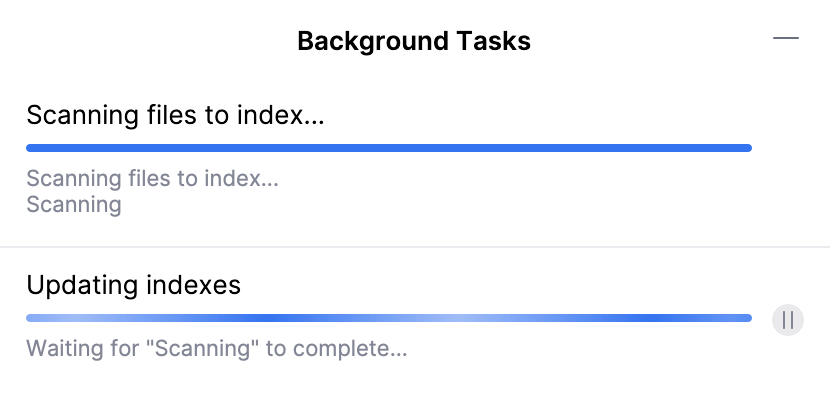Indexing
tip
For more information about restarting the indexing process, refer to Invalidate caches.
Indexing in DataGrip is responsible for the core features of the IDE: code completion, inspections, finding usages, navigation, syntax highlighting, and refactorings.
It starts when you open your project, switch between branches, after you load or unload plugins, and after large external file updates. For example, this can happen if multiple files in your project are created or generated after you build your project.

Indexing examines the code of your project to create a virtual map of objects and code elements that make up your script. This is necessary to provide the coding assistance functionality, search, and navigation instantaneously. After indexing, the IDE is aware of your code. That is why actions like finding usages or smart completion are performed immediately.
While indexing is in progress, the above-mentioned coding assistance features are unavailable or partially available. Nevertheless, you can still work with the IDE: you can type code, work with VCS features, configure settings, and perform other code-unrelated actions.
The right part of the status bar shows the progress of the indexing process. You may select Show all to view the specific tasks in the Backround Tasks dialog.

There are two main background tasks that are part of the indexing process: Scanning files to index and Updating indexes.

note
There is no option to pause, resume, or cancel the Scanning files to index process. However, you may pause and resume the Updating indexes process. You cannot cancel it, though.
In order to have access to smart IDE functionality such as code completion and smart navigation, the Updating indexes process must have completed. However, the Scanning files to index process can still be in progress because it does not interrupt the access to smart IDE functionality.
The amount of time required for indexing varies depending on your project: the more complex your project is, the more files it comprises, the more time it takes to index it. You can decrease the indexing time by excluding files and folders and by unloading modules.
note
If indexing is already in progress, you cannot speed it up. Wait for the process to finish, and then you can temporarily simplify your project. Next time, indexing will finish sooner.
Marking files as excluded can speed up the indexing and overall IDE performance. Excluded files remain a part of the project, but are ignored by code completion, navigation, indexing, and inspections.
For more information about detaching and excluding files and directories from projects, refer to Managing files and directories.
Right-click a file in the Files tool window .
Select Override File Type | Plain text.
Plain text files are marked with the
icon.
